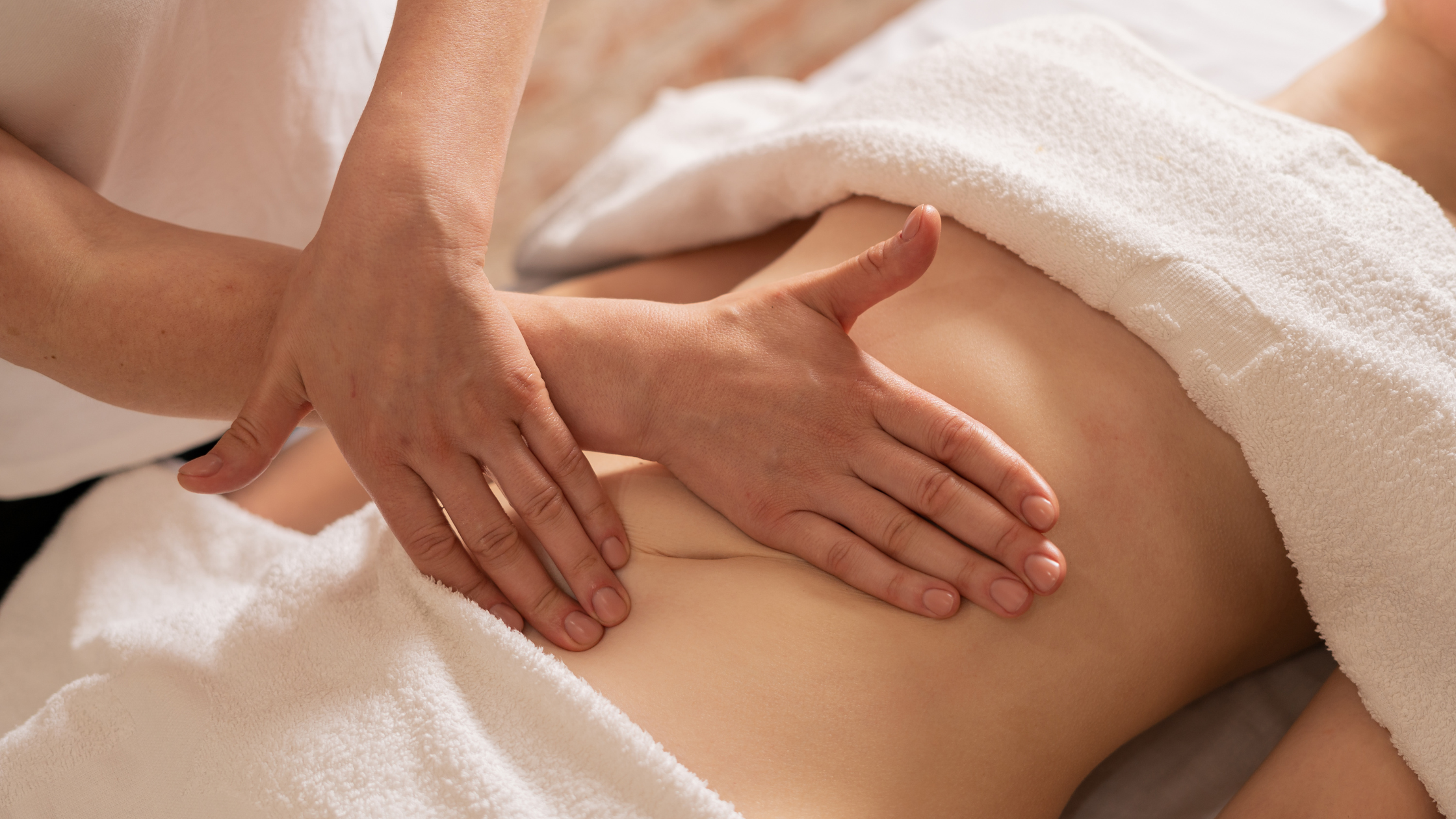Lymphatic drainage massage, also referred to as manual lymphatic drainage, alleviates swelling caused by blockages in the lymphatic system due to medical treatment or illness. It entails gently manipulating targeted areas of the body to facilitate the movement of lymph towards regions with functional lymph vessels.
Lymphatic drainage is a therapeutic massage technique that stimulates the movement of lymph fluids in the body. This process aids in detoxification, reduces swelling, and enhances overall health. The lymphatic system plays a crucial role in maintaining a healthy immune system and body fluid balance. By employing gentle, rhythmic massage movements, lymphatic drainage can encourage the natural drainage of the lymph, which carries waste products away from the tissues and back toward the heart.
This treatment is beneficial for individuals experiencing lymphedema, post-surgery recovery, or those seeking to rejuvenate their immune function. Through the promotion of efficient lymph flow, this therapy can help alleviate pain, improve metabolism, and support the body’s internal filtration mechanisms. Embracing the healing touch of lymphatic drainage can be a transformative addition to a holistic wellness regimen.
Introduction To Lymphatic Drainage

Lymphatic drainage is a gentle massage. This massage helps your body keep a balance of fluids. It supports your immune system too. The lymph system is like a cleaning crew for your body. But sometimes, it needs help. This is where lymphatic drainage comes in handy.
The Lymphatic System’s Role In The Body
The lymphatic system is a network. It has lymph nodes and vessels. These tubes carry a clear fluid called lymph. Lymph has white blood cells. These cells fight infections. Your lymph nodes trap and destroy bad things like viruses.
- Lymph nodes are checkpoints for your immune system.
- Vessels are highways for lymph to travel around the body.
- Your tonsils, spleen, and thymus are part of this system too.
How Lymphatic Drainage Contributes To Health
Lymphatic drainage massage boosts your health. It moves lymph through your body faster. This can reduce swelling and improve healing. It’s like when you turn up the water in a stream to clean it out.
| Benefits of Lymphatic Drainage |
|---|
| Reduces swelling and puffiness |
| Boosts immune system function |
| Helps the body heal after surgery |
| Supports detox of the body |
Regular lymphatic massages can make you feel lighter and healthier. They keep your lymph movement in check. Make sure to talk to a professional. They can guide you on how often you should get a massage.
Mechanics Of Lymphatic Drainage
The Mechanics of Lymphatic Drainage is an intricate process. It plays a crucial role in our body’s immune system. This process helps to remove toxins, waste, and other unwanted materials from our body. Understanding how lymphatic drainage works can lead to better health and well-being.
Lymph Flow And Natural Drainage Process
The lymphatic system behaves much like a secondary circulatory system. Its main job is to transport lymph, a clear fluid containing white blood cells, throughout the body. This system is essential to keep the body’s immune defenses in check.
Lymph moves through the body in the following way:
- Lymph capillaries absorb excess fluid from tissues.
- Lymph vessels transport the fluid to lymph nodes.
- Lymph nodes filter out harmful substances.
- Clean lymph returns to the venous bloodstream.
Unlike blood, lymph does not have a heart to pump it. It relies on other mechanisms to move, such as muscle movement and breathing.
Factors Affecting Lymphatic Circulation
Several factors can influence how well the lymphatic system works. These include:
| Factor | Impact on Lymph Flow |
|---|---|
| Physical Activity | Boosts circulation |
| Hydration | Helps lymph fluid move |
| Diet | High-nutrient foods support lymph health |
| Stress | Can slow down lymph flow |
| Illness | May cause lymph system to work harder |
Lymph flow can be improved through massages and exercise. The right balance in diet and lifestyle choices supports the lymphatic system.
Health Benefits Of Lymphatic Drainage
The lymphatic system plays a crucial role in our overall health. It’s like the body’s inner sanitation center, working tirelessly to cleanse waste and toxins. Lymphatic drainage is a gentle massage technique designed to enhance this system’s function. Let’s dive into its abundance of health benefits.
Detoxification Through Lymphatic Therapy
Lymphatic therapy acts as a natural detox for your body. It successfully removes unwanted substances and supports your body’s internal cleansing processes. Here are the key detoxification benefits:
- Promotes the removal of metabolic waste.
- Enhances the body’s ability to purge toxins.
- Supports overall detoxification, contributing to improved health.
Strengthening Immunity With Lymphatic Support
A strong immune system is vital for fighting off illness. Lymphatic drainage massage boosts this crucial defense mechanism. Here’s how it fortifies your immunity:
- Stimulates the production of antibody-producing cells.
- Encourages lymph flow, which transports white blood cells through the body.
- Helps in reducing the frequency of getting sick.
Lymphatic Drainage For Reducing Inflammation
Inflammation can be the body’s response to injury or infection. Lymphatic massages reduce such swelling and foster healing. Below are the inflammation-reducing benefits:
| Benefit | Description |
|---|---|
| Decreases Swelling | Reduces fluid buildup in affected areas. |
| Alleviates Pain | Lessens the discomfort caused by inflammation. |
| Speeds Recovery | Enhances the healing process post-injury. |
Applications In Medical Treatments
Lymphatic drainage plays a crucial role in various medical treatments. By aiding in the removal of bodily fluids and waste products, it has significant therapeutic applications. This section explores how lymphatic drainage benefits patients across different medical fields.
Post-surgical Recovery And Lymphatic Care
After surgery, patients often face complications like swelling and fluid retention. Lymphatic drainage can accelerate the healing process. It reduces swelling and supports the immune system. Here’s how this technique helps:
- Reduces post-operative swelling
- Speeds up the removal of toxins and waste from surgical sites
- Promotes tissue regeneration and healing
Lymphatic Drainage In Oncology Patients
Cancer treatments like surgery and radiation can disrupt normal lymphatic function. This can lead to lymphedema, where excess fluid collects in tissues causing swelling. Lymphatic drainage therapy is pivotal in managing these symptoms.
| Treatment | Benefits |
|---|---|
| Manual Lymphatic Drainage | Encourages lymph flow and reduces swelling |
| Compression Therapy | Maintains drainage improvements and supports vascular health |
| Exercise | Promotes lymphatic function and enhances overall well-being |
Managing Lymphedema With Targeted Techniques
Lymphedema, a condition with long-term effects, is best managed with targeted lymphatic drainage methods. These tailored techniques help keep symptoms in check:
- Manual lymphatic mapping to direct fluid towards working lymph nodes
- Bandaging and compression garments to maintain reduced limb size
- Pneumatic compression pumps to assist in fluid movement
Lymphatic Drainage Techniques
The lymphatic system plays a key role in keeping the body healthy. It removes waste and toxins. Lymphatic drainage techniques support this critical system. Each technique offers benefits to overall wellness. Explore the different methods used to stimulate lymphatic flow below.
Manual Lymphatic Drainage Massage
Manual lymphatic drainage (MLD) is a gentle massage. It aims to move lymph fluids around the body. Certified therapists use specific rhythm and pressure. This helps reduce swelling and improves circulation.
The sequence often begins at the neck. Then, follows key points to the rest of the body. It’s suitable for most individuals. Regular sessions may offer the best results.
Technological Advancements In Lymph Therapy
Science has enhanced lymphatic therapy. New devices help with drainage. Some use gentle vibrations. Others apply subtle heat. These advancements offer convenience and efficiency.
- Compression machines: Mimic the MLD process
- Lymphatic vibration plates: Stimulate the lymph through movement
- Infrared sauna: Use heat to encourage detoxification
Professionals may recommend these tools. They complement traditional manual therapy.
Diy Lymphatic Exercises For Wellness
At-home exercises boost lymph flow. Simple movements activate the system. They can be done daily. They are free and easy.
Jumping: A few minutes on a rebounder stimulates the lymph. Stretching: Enhances fluid movement. Deep breathing: Expands the abdomen, helping lymph movement.
These exercises require no equipment. They bring multiple health benefits. Always start slowly. Increase intensity as comfort allows.
Embracing A Lymphatic-healthy Lifestyle
Your lymphatic system is a superhero, quietly working around the clock to clean up and protect your body. Think of it as your internal housekeeper, taking out the trash and guarding your cells against invaders. Leading a lymphatic-healthy lifestyle not only supports this silent hero but also boosts your overall well-being. Here’s how you can optimize this vital system with some easy lifestyle tweaks.
Dietary Choices That Promote Lymphatic Function
What you eat can be your lymphatic system’s best friend or worst enemy. Go for foods that say “yes” to lymph health:
- Leafy greens equip your lymph with cleaning power.
- Low-sugar fruits like berries provide cellular support.
- Spices such as turmeric reduce inflammation.
- Healthy fats from avocados and nuts ensure smooth lymph flow.
The Impact Of Hydration On Lymph Flow
Your lymphatic system thrives on water. Proper hydration keeps the lymph moving, preventing blockages and maintaining its cleansing routine. Aim for the magic number of eight 8-ounce glasses daily. Here’s a hydration tip: start your day with a warm lemon water to wake up your lymph first thing in the morning.
Combining Physical Activity With Lymphatic Health
Movement is life for your lymph. Unlike your heart, your lymph system doesn’t have a pump. It relies on your actions to get it going:
- Jumping on a trampoline shoots lymphatic cleansing into high gear.
- Yoga twists and stretches help lymph flow.
- Even a brisk walk can significantly enhance lymph movement.
Incorporate these simple habits into your daily routine and consider your lymphatic system supported.

Credit: www.marasmedspa.com
What Does Draining Your Lymphatic System Do?
Draining your lymphatic system through techniques like lymphatic drainage massage or other methods facilitates several important functions in the body:
-
Removal of Toxins and Waste Products: The lymphatic system acts as a drainage network, collecting cellular waste, toxins, and excess fluids from tissues throughout the body. Draining the lymphatic system helps to remove these substances, promoting detoxification and maintaining tissue health.
-
Immune System Support: Lymphatic fluid carries immune cells, such as lymphocytes and macrophages, throughout the body. By draining the lymphatic system, you support the immune system’s ability to detect and respond to pathogens, infections, and abnormal cells.
-
Reduction of Swelling and Edema: When the lymphatic system becomes congested or impaired, fluid can accumulate in tissues, leading to swelling and edema. Draining the lymphatic system helps to alleviate this buildup of fluid, reducing swelling and promoting proper fluid balance in the body.
-
Enhanced Circulation: The lymphatic system works closely with the cardiovascular system to maintain fluid balance and circulation. By draining the lymphatic system, you promote the movement of lymph fluid and improve overall circulation, which can benefit tissue health and function.
-
Improved Nutrient Transport: Lymphatic vessels absorb fats, fat-soluble vitamins, and other nutrients from the digestive system and transport them to the bloodstream. Draining the lymphatic system ensures efficient nutrient transport and absorption, supporting overall health and vitality.
In summary, draining the lymphatic system supports detoxification, immune function, fluid balance, circulation, and nutrient transport in the body, contributing to overall health and well-being.
How Do I Know If I Need Lymphatic Drainage?
Determining if you need lymphatic drainage typically involves recognizing symptoms associated with lymphatic congestion or dysfunction. These symptoms may include:
- Persistent swelling or edema in specific areas of the body, such as the arms, legs, or face.
- Feeling of heaviness or discomfort in the swollen areas.
- Restricted range of motion in affected limbs.
- Recurrent infections, particularly in the skin or respiratory tract.
- Chronic fatigue or feelings of sluggishness.
- Skin changes, such as thickening or hardening.
- Pitting edema, where pressing on the swollen area leaves an indentation.
- Delayed wound healing.
- Pain or discomfort in the lymph nodes.
If you experience these symptoms, especially in the context of medical treatment or illness affecting the lymphatic system, consulting with a healthcare professional, such as a lymphedema therapist or a physician, can help determine if lymphatic drainage massage may be beneficial for you. They can provide a proper diagnosis and recommend appropriate treatment options.
What Happens To Your Body After A Lymphatic Drainage?
After a lymphatic drainage massage, several physiological changes occur in the body:
-
Reduced Swelling: The massage helps to move excess lymph fluid away from congested areas, leading to a reduction in swelling or edema.
-
Improved Circulation: Lymphatic drainage massage enhances lymphatic circulation, which can also indirectly improve blood circulation in the body.
-
Enhanced Immune Function: By promoting lymphatic flow, the massage supports the immune system’s ability to remove toxins, waste products, and pathogens from the body, potentially boosting overall immune function.
-
Relaxation: Lymphatic drainage massage techniques are often gentle and rhythmic, promoting relaxation and reducing stress levels.
-
Detoxification: The massage may aid in detoxification by facilitating the removal of metabolic waste products and toxins from the tissues.
-
Pain Relief: Some individuals experience pain relief after lymphatic drainage massage, particularly if the swelling was contributing to discomfort or restricted movement.
-
Improved Skin Health: By promoting lymphatic flow and circulation, the massage may contribute to healthier-looking skin by removing excess fluid and toxins from the tissues.
It’s important to note that individual responses to lymphatic drainage massage may vary, and the effects may be influenced by factors such as the severity of lymphatic congestion, overall health status, and consistency of massage therapy. Additionally, staying hydrated and engaging in light physical activity after the massage can further support the body’s lymphatic system.
How Does Lymphatic Drainage Make You Feel?
Lymphatic drainage can leave you feeling energized and refreshed. It often reduces swelling and detoxifies the body, promoting a sense of wellness.
Conclusion
Understanding lymphatic drainage can be integral to maintaining good health. This gentle massage technique supports your body’s natural detoxification process and can boost your immune system. By embracing this practice, you might just find the balance and rejuvenation your body craves.
Remember, a harmonious lymphatic system is key to overall wellbeing.



